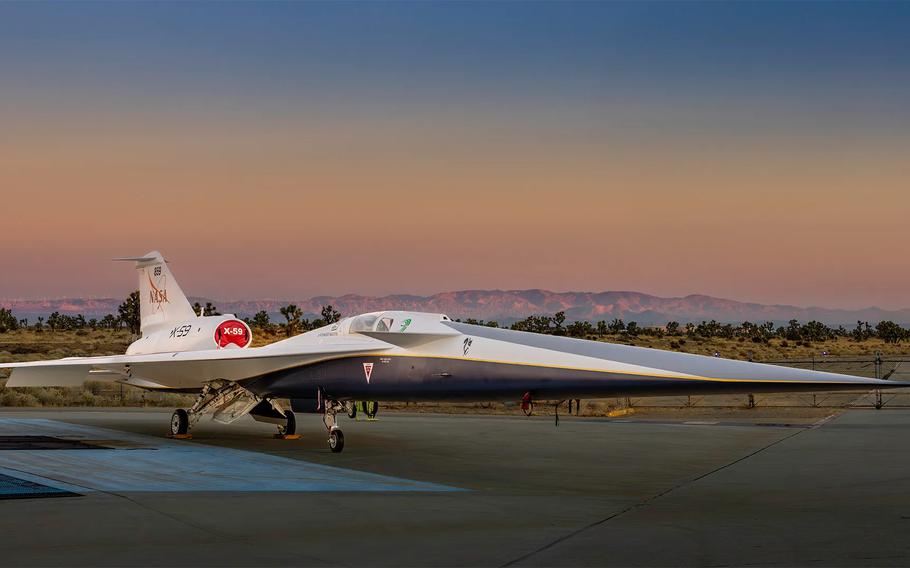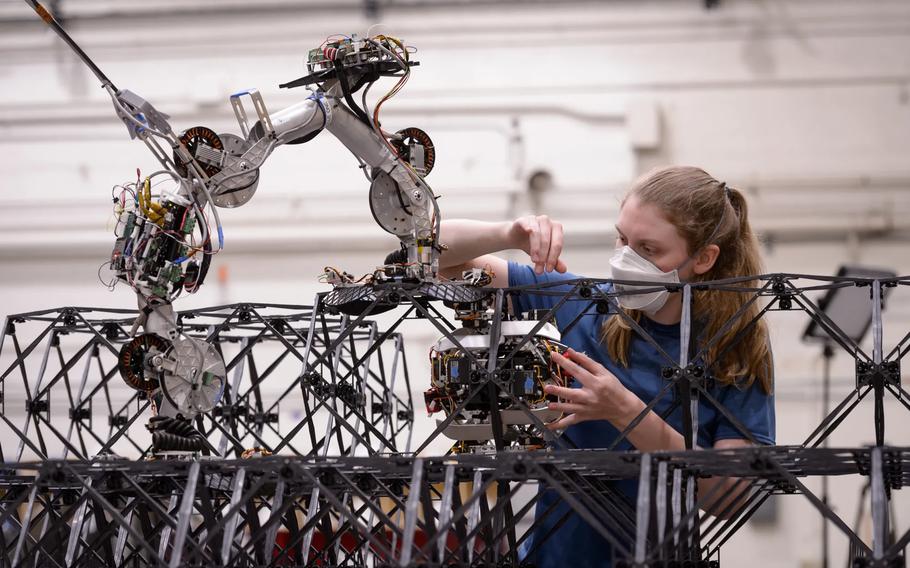
NASA’s X-59 quiet supersonic research aircraft sits on the apron outside Lockheed Martin’s Skunk Works facility at dawn in Palmdale, Calif. The X-59 is the centerpiece of NASA’s Quesst mission, which seeks to address one of the primary challenges to supersonic flight over land by making sonic booms quieter. (Lockheed Martin Skunk Works)
(Tribune News Service) — Make American airplanes the best and fastest in the world.
When a 16-foot wind tunnel was erected in Sunnyvale in the early days of World War II, that was the mission of Ames Aeronautical Laboratory at the U.S. Naval Air Station at Moffett Field.
Now a new 40,000-square-foot research facility called the Biosciences Collaborative Laboratory has taken its place, exploring fields that once seemed unimaginable, such as human survival in outer space.
The extraordinary effort that has unfolded on the site — now run by NASA, with Moffett Field property leased to Google — is central to the story of Silicon Valley. Through advanced research and development, NASA created a future that didn’t just happen, but was made by local men and women, day by day.
Built on the site of an ancestral Ohlone village, which was itself covered with broccoli, cauliflower and hay farms, the lab’s construction was not predestined. It’s here only because it won a fierce national competition, chaired by famed aviator Charles Lindbergh, because of its easy access to Moffett Field, major aviation industry leaders, good weather and a new high-powered electrical station in Sunnyvale.
It was a time of deep national anxiety. As World War II escalated, enemy labs more extensive than ours in the dictatorships of Germany and Italy were innovating new aircraft design features.
The future of the democracy was at stake, warned Vannevar Bush, who led a quiet, efficient group of government research engineers known as the National Advisory Committee for Aeronautics.
“No matter how greatly production facilities may be increased, no matter how many more pilots may be trained, unless the aircraft that are built for action are at least equal in performance to those of any possible enemy, the whole effort will be largely wasted,” he told President Franklin D. Roosevelt in 1941.
When the first spade of dirt was overturned in 1939 to inaugurate the construction of the new campus, called the Ames Aeronautical Laboratory, it was the era of slide rules and rudimentary electric calculating machines. A wooden shack served as an office for planning the construction of the first facilities. In its first year, the lab had only 60 employees. Now there are more than 3,200.
It was named for physicist Joseph S. Ames, a leader in the modern science of aeronautics and president of Johns Hopkins University. A critic of the United States’ isolationist foreign policy, Ames had urged the nation to speed up development of warplanes and helped persuade Congress to authorize the lab’s construction.
Sadly, Ames never visited the new research facility which bore his name. Disabled by a stroke, he died in 1943 at age 79.
Initial development of the campus focused on the construction of massive wind tunnel facilities to test models and full-scale wartime airplanes. Time was of the essence. Researchers rotated through shifts, three a day, so the lab could operate around the clock.
The Lab’s goal: increase the speed of airplanes from 125 miles per hour to 200 miles per hour, while boosting safety. Its researchers also tested crucial design changes, such as engine buffeting and icing, boosting its reputation as a place where clever and economical answers could be found to challenging problems.
Lab engineers fixed the vibrating radiator, or “duct rumble,” on the P-51 B Mustang fighter aircraft. They designed a new wing flap for the P-38 Lightning fighter, dangerous during steep fast dives. They increased the carrying capacity of the Boeing B-29 Superfortress bomber.
When the war’s fighting ceased, Ames Aeronautical Laboratory continued its research of lift, drag and other forces in flight — but its focus shifted to high-speed commercial aviation, revolutionizing the way people and goods traveled around the globe.
The Soviet launch of Sputnik in 1957 propelled the nation into the space age. The lab, long committed to the engineering of aviation, initially resisted the new focus. But NASA subsumed Ames, renaming it NASA Ames Research Center — and shifted its work on the technological challenges of a lunar landing and space travel.
Generations of spacecraft passed through its Unitary Plan Wind Tunnel for essential testing, from early rockets to the Artemis program’s Orion, designed to carry people into space and return them to Earth.
In 1994, Moffett Field was closed as part of the nation’s Base Realignment and Closure process. It was turned over to NASA Ames.
But soon the facility faced an existential crisis. In 1995, funding shortfalls prompted NASA to improve efficiency. While Ames’ aeronautics and other non-space research work would be saved, its space programs were destined for Houston and other NASA sites.
Facing a very real threat of closure, the crisis galvanized the lab’s Bay Area allies. NASA Ames pulled through and emerged from the upheaval as a leader in astrobiology, information technology, aviation system safety and other areas of expertise.
Now, with dreams of an expanded presence in space, NASA Ames is reducing its Earthly footprint.
Sitting alongside Google’s headquarters, it has deepened its ties with the tech company. Founders Larry Page and Sergey Brin, along with chairman Eric Schmidt, use Moffett Airfield as a base for their private jets. More recently, Google signed a 60-year, $1.16 billion contract with NASA to lease 42 acres for the company’s testing of technology related to robotics, aviation, space exploration and other new fields.
“We want to invest taxpayer resources in scientific discovery, technology development and space exploration not in maintaining infrastructure we no longer need,” said NASA administrator Charles Bolden.
NASA Ames is also expanding its relationships with industrial, government and university partners. It collaborates with Uber, Nissan North America and others in the field of autonomous vehicles. It performs key research for the Federal Aviation Administration, gathering information that shapes national tools and regulations.

Research engineer Christine Gregg inspects a Mobile Metamaterial Internal Co-Integrator (MMIC-I) builder robot. These simple robots are part of a hardware and software system NASA researchers are developing to autonomously build and maintain high-performance large space structures comprised of building blocks. MMIC-I works by climbing though the interior space of building blocks and bolting them to the rest of the structure during a build or unbolting during disassembly. (Dominic Hart/NASA)
Last month, plans for a major $2 billion innovation hub were unveiled. UC Berkeley and SKS Partners, a San Francisco-based commercial developer, will create the 36-acre Berkeley Space Center at Moffett Field to launch breakthroughs in astronautics, quantum computing, climate studies and other fields.
Only a glimpse of the work at NASA Ames is on view to the public, such as Google’s massive restoration effort of iconic Hangar One.
Everything else is hidden behind closed doors. An active research laboratory, the lab does not host public tours. Its Visitor Center isn’t even based there; instead, it is located 43 miles north at Oakland’s Chabot Space and Science Center.
But here are some examples of Ames’ historic contributions:
Swept wings:
As plane speeds approach the velocity of sound, the airflow over the wings abruptly changes. This causes a dangerous loss of lift and increase in drag.
In 1946, Ames discarded straight wings and tested the theory of “swept” design, with wings angled back from the fuselage to reduce drag at transonic, supersonic and high-subsonic speeds. Swept wings remain with us today on all modern aircraft.
Round noses:
A pointy nose cone greatly improves the aerodynamics of a flying object. But it can’t handle heat. When re-entering the Earth’s atmosphere, it burns up.
In the 1950s, NASA Ames found that a blunt tip dissipates heat more efficiently, ensuring the safe return of capsules and probes. This counterintuitive rounded shape has been incorporated into vessels from NASA’s Orion Spacecraft to SpaceX’s Dragon capsule.
Wind tunnels:
Before something can fly in the sky, it needs to “fly” on the ground. Generations of flight vehicles have passed through one of the three test sections of the lab’s Unitary Plan Wind Tunnel — the 11-by-11-foot Transonic, 9-by-7-foot Supersonic and the 8-by-7-foot Supersonic.
The famed Boeing fleet of commercial transports and the Douglas DC-8, DC-9 and DC-10 were all tested in these tunnels. So were military aircraft such as the F-111 fighter, the C-5A Galaxy transport and the B-1 Lancer bomber. The Space Shuttle was also tested there, as well as NASA’s newest supersonic X-59 plane and its next great rocket, the Space Launch System (SLS).
Vertical flight:
Ames’ expertise has contributed to the development of powered lift, stability and control, essential to improved helicopter and “tiltrotor” aircraft, which can conduct amphibious assaults at twice the speed of traditional helicopters, making them less vulnerable to antiaircraft fire.
Its experiments led to the V-22 aircraft of the 1980s, which climbs and lands like a helicopter but flies as a turboprop plane. Related innovation led to the development of the Mars helicopter Ingenuity, which made history by traveling the length of a football field through thin air.
Drone traffic:
Drones could cut commute times, provide medical transport, deliver disaster relief, assist in firefighting and send groceries, toiletries or a box of pizza to your front door.
But this will require intense management of airspace. Software development and simulation facilities at Ames will help coordinate future drone traffic, so they don’t swarm haphazardly, perhaps colliding and careening to the streets below. Ames scientists are also developing airspace management tools to support the adoption of drones during wildfires.
Eyes in space:
It’s hard for Earth-bound telescopes to see through the water vapor of the atmosphere. NASA Ames co-managed SOFIA ( Stratospheric Observatory for Infrared Astronomy), a 106-inch, 17-ton infrared telescope mounted inside a 747 jumbo jet, to view the skies more clearly.
SOFIA, which began work in 2014 and concluded its final science flight in 2022, provided unambiguous evidence of water on parts of the moon.
Heat shields:
NASA’s new Artemis program aims to put astronauts back on the moon, evoking the long-gone Apollo era. But its spacecraft are at risk of becoming fireballs as they race 25,000 miles per hour at temperatures of nearly 5,000 degrees Fahrenheit.
To protect the spacecraft, heat shields rely on a thermal material, called phenolic-impregnated carbon ablator, or PICA, that was designed in Ames’ specialized wind tunnels. The heat shields were also critical to the survival of the capsule used in this year’s OSIRIS-REx project, which brought asteroid samples back to Earth.
Moon ice:
Astronauts get thirsty. Water ice trapped at the bottoms of craters on the moon’s south pole could help support them.
A golf cart-sized robot — the Volatiles Investigating Polar Exploration Rover, or VIPER — will prospect for ice, analyzing it at different depths to create maps and revealing whether it is crystallized or chemically bound to other materials. Ames is managing the VIPER mission.
Our origins — and life in space:
Ames researchers studied samples of comets and interstellar dust from the Stardust mission, unlocking clues to the origins of our solar system. They inspected lunar samples to check for signs of life when Apollo 11 returned from the moon. They studied the wealth of chemical data from the Viking mission to the surface of Mars.
Its Biosciences Collaborative Laboratory is developing the next generation of life support systems, so we can live in space for extended periods of time, as well as countermeasures to protect us from radiation exposure and loss of gravity.
In the future, the question faced by the lab’s space scientists will be, in the end, not all that different from the challenge of their predecessors desperate to win World War II:
Can we build it better? Faster? The answer might well be decided at NASA Ames.
©2024 MediaNews Group, Inc.
Visit mercurynews.com.
Distributed by Tribune Content Agency, LLC.